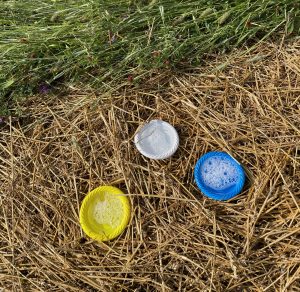Pan Trap Data Collection

One of the 13 sets of pan traps that make up the backbone of our study.
Every two weeks, student researchers conduct a population survey of pollinators visiting the Pine Patch and College Garden.
Pan Traps, also referred to as Bee Bowls, aim to attract the attention of our six-legged friends with their bright florescent colors. A relatively straight-forward route of data collection, pan traps work by filling small bowls with water and a dash of Dawn dish soap. While the fragrant smell helps to entice insects visiting the trap to attempt collecting pollen, its main purpose is to alter the surface tension such that they cannot leave upon landing.
Although this becomes the last stop for our miniscule guests, in 24 hours each visitor is carefully collected and later catalogued by our team of student researchers. Tracking each visitation is vital towards long-term data analysis, so every bee, butterfly, beetle, or fly that takes part in our experiment will retain their value for decades to come. Furthermore, studies have shown that this form of sampling has little to no effect on the overarching population of the species that end up in one of our bowls.
If you would like to see some of the samples we have collected, or show your appreciation for their sacrifice please take a moment to check out our iNaturalist.org!